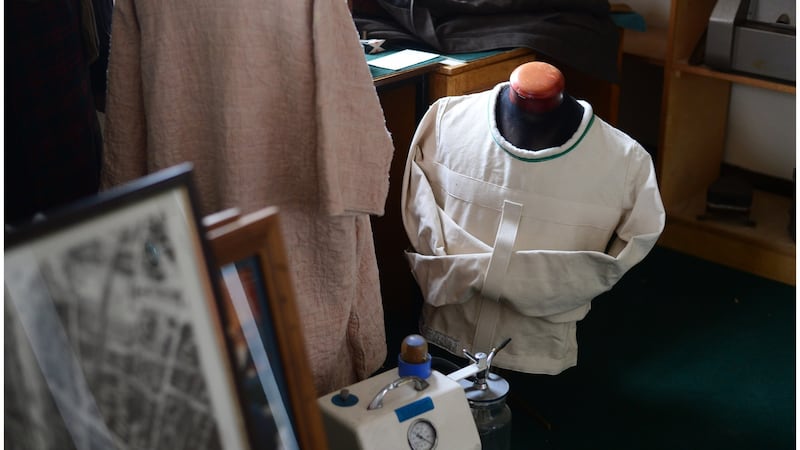
In 1905, the Spanish writer and philosopher George Santayana wrote that “those who do not remember the past are condemned to repeat it”. Santayana’s insight echoed a similar, earlier statement by Edmund Burke “Those who don’t know history are doomed to repeat it.” These statements hold particular relevance for the history of psychiatry in Ireland by Brendan Kelly, and it is the first book to describe this history from earliest times to the present day. It is, in Kelly’s words, a “history of therapeutic enthusiasm, with all of the triumph and tragedy, hubris and humility that such enthusiasm brings”. It is a gripping, fascinating tale, told here with elegance, enthusiasm and erudition.
Kelly’s book commences with the ancient myths of Mad Sweeney and Gleann na nGealt, a healing well in Kerry, where the “mad” were said to be cured. Societal interpretations of mental illness underwent a seismic change in the late 1700s and early 1800s, and Kelly duly explores the work of Dr William Hallaran in Cork (Ireland’s original “spin doctor”, who believed in rotating patients at high speed in suspended chairs), before documenting the emergence of Ireland’s vast asylum system in the late 1700s and 1800s. The first asylum to be opened was St Patrick’s in Dublin, funded by the generous bequest of Jonathan Swift, who, in his epitaph stated “He gave the little Wealth he had, To build a Home for Fools and Mad, and shew’d by one satyric Touch, No Nation wanted it so much.”
The Irish asylums of the 1800s expanded much faster than those elsewhere, prompting the suggestion that the Irish were especially prone to madness. Kelly demonstrates comprehensively that this was not so. Irish burgeoning asylums were fuelled, not by an excess of mental illness, but by a toxic mix of poverty, bad laws and vested interests, compounded by a major reduction in population following the Famine. This persisted well into the 1900s.

I remember the visceral horror I felt on visiting St Brendan’s Hospital, Grangegorman, in 1958 and seeing, the Richmond asylum, the old workhouse and prison buildings grossly overcrowded with some 2,000 patients: many were mentally ill or demented, but others were just terrified to be there. One recollection is burned into my mind. In one ward, as I was passing, an old lady,who looked completely sane and could have been my own mother, was in bed beside a demented epileptic, who was banging a screen over on top of her. The old lady looked completely terrified. I was not conscious of it at the time, but something inside me left a deep resolve, that someday I would return to fundamentally change that appalling reality.
Ever since it opened in 1814, Grangegorman enjoyed frequent periods of enlightened reform, including the “moral management” of the early 1800s, an asylum school championed by Dr Lalor in the mid-1800s, and Dr Conolly Norman’s de-institutionalisation initiative of the early 1900s that was comprehensively stymied by Dublin Castle, always keen to sustain the economic value of the huge institutions. As Kelly notes, this cycle of attempted reform and institutional retrenchment soon appeared inexorable:
“Anyone who came to this volume expecting [a] relentlessly uplifting account has realised by now that the history of psychiatry in Ireland is anything but linear, logical or uplifting. The same ideas emerge repeatedly (eg institution-based care, community care); similar patterns recur (eg new legislation modifies but does not fundamentally reform existing law; the mentally ill become even more socially excluded); and chillingly familiar problems beset every generation of doctors, policymakers and patients, chiefly related to the enormous chasms between official rhetoric and the lived experience of mental disorder in Ireland.”
The profession of psychiatry had its fair share of dark moments in this story. And Kelly, although he is a consultant psychiatrist himself and professor of psychiatry at Trinity College Dublin, as well as an historian, does not shy away from these. He explores the horrors of “novel” therapies that I remember well, such as lobotomy (“possibly the biggest single mistake in the history of psychiatry”, the originator of which – Antonio Moniz, received a Nobel Prize); the operation for which I assisted, every Saturday morning, during my first six months as a doctor, in the old Richmond hospital. This consisted of drilling two burr-holes, introducing a knife and separating the frontal lobes completely from the rest of the brain, turning the person into a virtual vegetable; also deep insulin coma therapy, a highly dangerous and totally ineffective therapy. (A colleague with whom I was working at the time failed to get the tube down into the stomach to bring the patient out of coma; putting it into the lungs instead, and reducing the poor patient, effectively, to a vegetative state); and psychiatric “treatments” of homosexuality.
The brooding legacy of the asylums, which Kelly describes as “an unmitigated disaster for the profession of psychiatry in Ireland, was to be haunted and defined by the idea of custodial asylum care for several generations to follow”. Arguably, it still is.
Kelly is circumspect in his criticisms of Ireland’s current psychiatric system. The problems therein include a lack of psychotherapy training among psychiatrists, excessive emphasis on the so-called biological at the expense of the psychological, and an implicit belief that the primary work of psychological healing can come from outside the person (from a psychiatrist or medication): true healing comes from within. Even following the wonders of modern surgery, the key to recovery still lies in the body’s own healing power. It is at our peril that we forget this.
In my own career as chief psychiatrist, (incorporating medical superintendent of St Brendan’s – 1965-1994), I encountered many of the challenges outlined in this book. I saw new medications offer great hope at first, only to disappoint in the longer term. I was seduced by the fad of repetitive, anti-therapeutic “industrial therapy”, allowing it to replace the much more meaningful activity already going on in Grangegorman, which functioned like a small town of 2,000 people and previously provided patients with worthwhile roles as bakers, printers, tanners, furniture restorers, etc.
In addition, rather than attempting to set up community psychiatry everywhere all at once in 1970s, it might have made more sense to set it up properly in one area first, study the lessons carefully, and then broaden the reforms. There were, however, difficulties getting dedicated staff (the first advertisement I tried to recruit medical staff attracted four alcohol/drug addicts and only one suitably qualified doctor – Joe Fernandes), despite the clear potential offered by the kind of community psychiatry and day centre work I saw in London with Dr Joshua Bierer in 1959/60, that I was attempting to introduce. In addition, as I discovered in Harvard where there was an Indian psychiatrist in our group; the shadow of the asylum loomed large in Ireland, a country where there were 20,000 psychiatric beds at the time, the same as in India, despite having less than 1 per cent of its population.
Kelly explores these recurring challenges using fascinating new historical material and engaging case histories from asylum archives that really bring this history to life. He also explores the effects of the 1916 Easter Rising on Dublin’s asylums (Kevin Barry was actually hiding in Grangegorman at the time); the pioneering work of the Richmond War Hospital (a shell-shock hospital that operated at Grangegorman during the first World War, demonstrating the therapeutic potential of small, focused, therapeutic units); the remarkable lives and careers of Ireland’s path-finding women psychiatrists (Dr Eleonora Fleury, Dr Ada English); and the spread of nationalist sentiment throughout the asylums during Ireland’s revolutionary years.
In Hearing Voices, the complex history of psychiatry in Ireland has finally received the treatment it so richly merits: this is a carefully crafted, highly readable, impeccably researched, beautifully illustrated book. It is generously leavened with moments of humour and human interest, and it tells a story that is by turns uplifting and dispiriting, but is never less than fascinating.
To his credit, Kelly emphasises the importance of preserving Ireland’s history of institutionalisation, especially as DIT establishes itself in the Grangegorman campus and other mental hospital buildings are variously re-purposed: if we forget this history, we will be condemned to repeat it. Towards the end of the volume, Kelly surveys contemporary mental health care and, while acknowledging areas of substantial progress, concludes – in a triumph of understatement – that “we must do better”. We certainly must!
But Kelly’s wonderful history really demonstrates to us that we need to do much, much more than this: we need nothing less than a revolution in mental health care and quite possibly a societal revolution too, placing genuine human compassion at the centre of human activity, human connection, and human flourishing. This is a big, important task, and Kelly’s essential, gripping book – the most important social history in more than a decade – makes an excellent beginning.
Ivor Browne is a former chief psychiatrist of the Eastern Health Board and professor emeritus of psychiatry at University College Dublin
